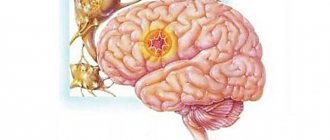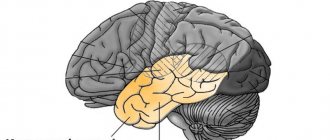Features of the disease
In medical practice, epilepsy is a complex neurological disease accompanied by sudden seizures and seizures. The disease is characterized by the fact that during an attack a person does not realize what is happening to him. As a result, patients do not remember the seizures, do not understand the degree of their intensity and are not able to describe what happened to them.
Temporal lobe epilepsy is one of the most common forms of the disease. This type of disease is accompanied by partial epileptic seizures of varying severity. The progression of pathology in the absence of adequate therapy threatens the occurrence of generalized seizures, as well as the development of various mental disorders and deformations.
There is also a classification of temporal lobe epilepsy, according to which there are 4 types of pathology, depending on the location of the epileptic focus:
- amygdala;
- hippocampal;
- lateral;
- opercular.
What is temporal lobe epilepsy
Many processes are concentrated in the temporal lobes. The nerve cells of these brain areas ensure normal memory functioning and are responsible for the perception of sound. The temporal lobe is also involved in the emotional process. If it is affected by an epileptic focus, a person may experience recurring feelings of anxiety, admiration, and anger. The perception of the surrounding conditions is also distorted. There is a feeling that the new place in which he finds himself is familiar to him (the so-called “déjà vu phenomenon”). Often this condition is accompanied by sound hallucinations.
Temporal lobe epilepsy is characterized by unprovoked seizures of varying severity. These are not single, but periodically recurring convulsive seizures, localized in the lateral temporal or medial lobe of the brain. Refers to a number of symptomatic epileptic pathologies. Depending on the type of attack, the excitation process can be localized and also spread to both temporal zones.
Depending on the location of the epileptic lesion within the temporal region, the following forms of this disease are distinguished:
- Amygdala epilepsy. Develops regardless of a person’s age. It is observed mainly in individuals of infant or school age. This temporal lobe epilepsy is characterized by severe psychomotor manifestations, accompanied by a disorder of consciousness. The patient's motor activity is preserved, but automated.
- Hippocampal. Accounts for about 65% of all cases of symptomatic temporal lobe epilepsy. The first manifestation of the disease occurs when the patient is at school age. Most patients experience atypical febrile seizures before the first attack.
- Lateral. Of all the forms of temporal lobe epilepsy, this is the most rare. The patient's age, as a rule, does not play a significant role in the development of the disease. This form is characterized by focal sensory attacks with pronounced manifestations: visual and sound distortions, dizziness in combination with vegetative symptoms, loss of consciousness.
- Opercular (insular). A form of frontotemporal epilepsy in which the lesion develops in the opercular zone of the brain. The clinical picture of convulsive attacks is represented by profuse salivation, clonic convulsions in the muscles of the face, neck and larynx, a tingling sensation in the throat and half of the face.
Since this form of epilepsy has a focal onset (in the temporal lobe), it belongs to a number of focal pathologies. At the moment, this concept applies to the nature of the seizures, and not to the form of the disease itself. The most relevant is the division of temporal lobe epilepsy into:
- Symptomatic. The most common and frequently occurring form of symptomatic disease is medial, or mesial, temporal sclerosis. Also in medicine there is such a concept as structural temporal lobe epilepsy, which refers to the morphological characteristics of the pathological condition.
- Idiopathic. With this form, there are no structural changes in the brain tissue. Develops under the influence of genetic factors.
- Cryptogenic. One of the most dangerous forms of temporal lobe epilepsy. The disease tends to progress. It is characterized by complex attacks accompanied by pain in the heart and abdomen. People with cryptogenic temporal lobe epilepsy may experience panic and olfactory and visual disturbances. Due to fear, patients may take unreasonable actions.
It should be noted that one or another form of temporal lobe epilepsy in its pure form is rare.
Expert opinion
Author: Georgy Romanovich Popov
Neurologist, Candidate of Medical Sciences
Doctors attribute the difficulty of diagnosing epilepsy to the variety of clinical forms of this disease. At present, the exact causes of the development of convulsive seizures have not been established. Temporal lobe epilepsy is often symptomatic. According to statistics, pathology can occur in people of any age; the earliest onset of seizures was recorded at 6 months. Temporal lobe epilepsy requires timely diagnosis and correct treatment.
Doctors at the Yusupov Hospital diagnose this form of the disease using modern medical equipment. European MRI, CT and EEG installations allow you to quickly determine the localization of the pathological focus. Experienced neurologists and epileptologists develop an individual treatment program based on diagnostic results. New drugs are prescribed for therapy that meet international standards for the treatment of temporal lobe epilepsy. Surgical intervention is performed solely according to indications. It is possible to achieve stable remission in 60-70% of cases. Each patient at the Yusupov Hospital is provided with personal preventive recommendations to minimize the risk of relapse of temporal lobe epilepsy.
Causes of temporal lobe epilepsy
As is the case with other forms of the disease, the main reason for the development of temporal lobe epilepsy is the formation of an epileptic focus in the brain. In this case, the pathological area is a certain area of the temporal lobe. An epileptic seizure is triggered by a sudden surge of excessive neuronal activity in the temporal lobe of the brain.
Today, doctors identify a lot of factors that predispose to the development of temporal lobe epilepsy, dividing them into two broad groups:
- Perinatal - have a negative effect on the brain during intrauterine development or labor. The group of perinatal factors includes various forms of fetal hypoxia, injuries received during childbirth, infectious diseases suffered by the mother during pregnancy, asphyxia in newborns, etc.
- Postnatal – acquired factors of a postnatal nature are much more numerous and varied. Among the most common are traumatic brain injuries, consequences of ischemic or hemorrhagic stroke, brain tumors, abscesses, aneurysms and various neuroinfections).
The first signs of temporal lobe epilepsy
Depending on the age at which temporal lobe epilepsy develops, its symptoms can be very diverse. Symptoms in adults differ from manifestations of the disease in children. In newborns, epileptic signs are difficult to distinguish from normal motor activity. As mentioned above, the disease is often preceded by atypical attacks of febrile seizures. As a rule, they begin in children between 6 months and 6 years. From the moment of the first seizure and for 2-5 years, the patient experiences spontaneous remission. Upon reaching 6 or 8 years of age, psychomotor seizures characteristic of temporal epilepsy occur.
Clinical picture
The main clinical sign of temporal lobe epilepsy is epileptic seizures. They arise suddenly and are expressed in the patient’s unconsciousness, loss of orientation, muscle cramps, etc. In this case, a characteristic feature is the fact that during a seizure the patient turns his head and squints his eyes towards the temple in which the area of epileptic activity is concentrated.
Other symptoms of temporal lobe epilepsy include:
- frequent, even systematic dizziness;
- headaches and migraines;
- visual and auditory hallucinations;
- olfactory paroxysms;
- squeezing or bursting sensation in the heart area;
- coordination problems;
- various forms of mental disorders;
- automation of gestures and sounds;
- personality distortions, etc.
Symptoms of temporal lobe epilepsy
A characteristic property of the multiple clinical symptoms of temporal lobe epilepsy in adults is the polymorphism of the disease. The main manifestations of the disease include seizures. They come in different types, and each of them has its own characteristics. Patients with temporal lobe epilepsy may experience either one type of seizure or a combination of them. Epileptic seizures include:
- simple partial seizures (SP);
- complex partial seizures (SP);
- secondary generalized seizures.
Approximately 75% of patients experience a so-called aura before the onset of a seizure. This condition is represented by a combination of olfactory sensations, visual and auditory disturbances, as well as psycho-emotional feelings. Aura is also considered as an independent attack and serves as a sign of progressive temporal lobe epilepsy. The nature of the aura is of great importance in identifying a more precise location of epileptic pathology in the temporal lobe of the brain. The presence of an aura is a kind of warning sign - the person is fully aware of it and can take measures to minimize the attack and its consequences. These types of attacks can be divided into:
- Motor. The eyes and head of a patient with temporal lobe epilepsy spontaneously turn in the direction in which the lesion is located.
- Sensory. A symptom of such attacks is the sensation of unusual odors that no one except the person with epilepsy can smell. In addition, there is a change in the taste of food, or the patient complains of an unusual taste in the mouth. The patient also feels dizziness, which is often combined with auditory and visual hallucinations.
- Vegetative-visceral. In these cases, the patient with epilepsy feels squeezing and swelling in the chest. Attacks of suffocation are also observed; many patients cannot get rid of the feeling of a lump in the throat. Seizures are accompanied by pain in the abdomen and heart. Often there is a feeling as if everything around is an illusion, from which the patient is paralyzed by panic fear
- Simple epileptic seizures leading to mental disorders. They arise in the form of a distortion of the patient’s perception of reality and himself. They indicate a mediobasal epileptic-pathogenic process in the temporal lobe. Characterized by a feeling of déjà vu, as well as a feeling that the passage of time has slowed down or sped up. In addition, during a convulsive attack, a person cannot navigate in space and feels as if his body and thoughts do not belong to him.
- Adversive and speech (phonatory). The patient speaks and repeats individual words and phrases. Sometimes they make sense, and sometimes they sound incoherent and are very difficult to understand. Temporary loss of speech is also possible.
Depending on the symptoms, complex partial seizures in focal temporal lobe epilepsy are divided into 4 groups:
- They begin with an aura and are accompanied by a disorder of consciousness.
- The same signs as the first group, with the addition of automatisms.
- Seizures with loss of consciousness.
- There is no aura, but the patient loses consciousness, and automatisms are present.
Another characteristic symptom of temporal lobe epilepsy is a frozen face like a mask. This also indicates a complex partial seizure. The patient's eyes are wide open, his gaze is motionless and directed at one point.
As temporal lobe epilepsy progresses, its symptoms become more pronounced and severe. Secondary generalized attacks develop, accompanied by loss of consciousness and clonic-tonic convulsions in all muscle groups.
If temporal lobe epilepsy is not treated in time, the patient may experience mental, emotional, personal and intellectual-mnestic disorders. They appear as:
- slowness;
- slow thinking;
- forgetfulness;
- emotional instability;
- aggressiveness and conflict.
Patients begin to show a tendency to detail, become overly detailed, and cannot distinguish the important from the unimportant. At the same time, they experience difficulty in generalizing, since fixation on details prevents them from concentrating and distracts them from consistent presentation. Since intellectual abilities are reduced, the patient’s speech loses its meaning.
A variety of neuroendocrine diseases in adults with temporal lobe epilepsy also indicate progression of the disease. They may differ depending on gender. Women experience menstrual irregularities and decreased fertility. Polycystic ovary syndrome can also occur against the background of temporal lobe epilepsy. Men suffer from decreased libido and impaired ejaculation.
Diagnostics
To make an accurate diagnosis, the doctor must compare a lot of factors. The primary diagnosis of temporal lobe epilepsy includes recording symptoms, frequency of attacks, drawing up a detailed medical history, and identifying possible causes or factors in the development of the disease.
Based on the data obtained during the initial diagnosis, the doctor determines the necessary laboratory and hardware tests:
- MRI of the brain;
- PET CT;
- electroencephalography;
- polysomnography.
Treatment
A complete recovery of the patient, that is, a complete absence of epileptic seizures throughout his life, is extremely difficult to achieve, and in some cases impossible. When resorting to conservative therapy, the main task that doctors set for themselves is to reduce the frequency of attacks and other manifestations of the disease to a minimum.
Conservative treatment of temporal lobe epilepsy involves the prescription and administration of antiepileptic drugs.
During drug therapy, the doctor systematically monitors the patient’s condition and progress from taking the prescribed medication. If undesirable side effects occur, treatment is adjusted, the drug is replaced, or additional symptomatic therapy is provided.
If no positive dynamics are observed from conservative therapy over a long period of time, surgical treatment of temporal lobe epilepsy may be required. For this purpose, experienced neurosurgeons are involved; the following operations for temporal lobe epilepsy are performed:
- temporal resection;
- focal resection;
- selective hippocampotomy;
- amygdalotomy.
Our clinic has everything necessary for accurate diagnosis, effective and comfortable treatment of patients with epileptic seizures. Patients with attacks of loss of consciousness are treated by neurologist-epileptologist Maxim Anatolyevich Palagin.
Treatment of temporal lobe epilepsy
Treatment measures for temporal lobe epilepsy are primarily aimed at reducing the frequency of seizures. When prescribing medications, doctors set themselves the priority task of achieving long-term remission of the disease.
In order to determine the most effective anticonvulsant drug, it is initially necessary to carry out monotherapy.
But advanced temporal lobe epilepsy is rarely treatable with monotherapy. In this case, it is necessary to switch to polytherapy with a combination of various drugs. Doctors can also prescribe sex hormones as additional medications, since in women the disease worsens during menstruation.
In addition to basic medications, barbiturates and benzodiazepines are also used.
Another method of treating epilepsy is neurosurgery. Removal of the lesion from the temporal lobe may have a beneficial effect on the further course of the disease. Indications for surgical intervention:
- detection of a lesion with precise localization;
- high purity of severe attacks;
- epileptic seizures are absolutely not amenable to drug treatment.
In the presence of severe intellectual and psycho-emotional disorders, surgery is not recommended.
Another important goal of therapy is to help patients with epilepsy with social adaptation. Treatment includes various types of psychological consultations. Specialists, friends and relatives of the patient should direct all their efforts to improve the quality of life of the patient with temporal lobe epilepsy. Even with strict adherence to the dosage and regimen of medications, there is a possibility that attacks will recur. Therefore, the conditions in which the patient lives and works must be as safe as possible.
Our specialists
Yushina Maria Alexandrovna
Head of the Center for Epilepsy and Paroxysmal Conditions.
The doctor is a neurologist. Epileptologist. Ozone therapist. Physiotherapist Experience: 7 years.
Kordonskaya Irina Sergeevna
Pediatric neurologist of the highest category. Epileptologist. Neurophysiologist (EEG diagnostic doctor). Experience: 24 years.
Volkova Svetlana Anatolevna
Head of the Center for Parkinsonism and Extrapyramidal Diseases.
The doctor is a neurologist of the highest category. Epileptologist. Ozone therapist. Physiotherapist. Experience: 26 years.
Derevianko Leonid Sergeevich
Head of the Center for Diagnostics and Treatment of Sleep Disorders.
The doctor is a neurologist of the highest category. Vertebrologist. Somnologist. Epileptologist. Botulinum therapist. Physiotherapist. Experience: 23 years.
Tarasova Svetlana Vitalievna
Expert No. 1 in the treatment of headaches and migraines. Head of the Center for the Treatment of Pain and Multiple Sclerosis.
Somnologist.
Epileptologist. Botulinum therapist. The doctor is a neurologist of the highest category. Physiotherapist. Doctor of Medical Sciences.
Experience: 23 years.Palagin Maxim Anatolievich
The doctor is a neurologist. Somnologist. Epileptologist. Botulinum therapist. Physiotherapist. Experience: 6 years.
Read also
Epilepsy and pregnancy
Managing patients with epilepsy and pregnancy is incredibly complex and challenging.
What are the features of pregnancy in patients with epilepsy? In 1-2% of cases there is a chance of developing epileptic... Read more
Causes of epilepsy
“Where did my seizures come from? There are no epileptics in our family!” - the most common phrase at the reception, we will tell you about the causes of epilepsy. Indeed, up to 70% of all epilepsies are genetically predetermined...
More details
Treatment of epilepsy in Samara
Epilepsy therapy is a long process and requires interaction between the epileptologist and the patient. Currently, it is possible to stop attacks and achieve remission in 60%! How to do it? Basic…
More details
Symptoms of epilepsy
How does epilepsy manifest? The most “famous” epileptic attack is a convulsive one, as the most “bright” one, this attack includes general tonic-clonic seizures, blueness of the face, salivation, ...
More details
Alcoholic epilepsy
In accordance with the International Statistical Classification of Diseases developed by the World Health Organization, alcoholism is considered a “dependence syndrome” and is included in the section of behavioral,…
More details
Vestibular epilepsy
For a long time, the concepts of “dizziness” and “epilepsy” were closely related to each other. So, in the 2nd century AD. it was believed that if dizziness is difficult to treat, then it may be based on epilepsy, while the attack of dizziness itself was considered a “minor epileptic seizure.”
The development of vestibular epilepsy (VE) is based on the same pathophysiological mechanisms as in other forms of epilepsy. Any congenital anomalies, injuries, vascular or other brain lesions can theoretically lead to the formation of an epileptogenic focus responsible for the development of the disease.
Localization of vestibular zones in the cerebral cortex, established by direct electrical stimulation of the cortex in patients with epilepsy.
Green and purple circles reflect the location of zones, upon stimulation of which patients noted a feeling of dizziness; colored figures - areas, upon stimulation of which, a visual illusion of rotation of objects arose.
Clinical picture
VE is manifested by attacks of dizziness, which may be the leading manifestation of seizures. The severity of vestibulopathic syndrome can be very diverse, from mild dizziness, which patients describe as the appearance of “fog in the head,” unsteadiness, to severe vertigo with an illusory perception of the movement of surrounding objects or the patient himself in different planes. Most often, the feeling of dizziness is accompanied by other symptoms: ringing in the ears, nausea and vomiting, less often taste and olfactory hallucinations, depersonalization, anxiety, and the deja-vu phenomenon. Adverse movements of the head and eyes are possible, combined with or without nystagmus. The development of VE attacks, like any other epileptic seizures, is provoked by sleep disturbances, alcohol intake, hypoglycemia and other well-known causes. In 20% of cases, patients with VE have a family history of various forms of epilepsy.
The diagnosis is confirmed by the detection of paroxysmal activity on the EEG, most often in the lateral temporal lobe.
Treatment
Treatment for VE is carried out in accordance with modern recommendations for the treatment of epilepsy. It is of great importance to follow the general rules for the prevention of epileptic attacks (excluding “strict” diets, drinking alcohol, smoking, normalizing sleep patterns, etc.). First-line drugs are carbamazepine and oxcarbazepine, which are effective in most cases.
← Back






